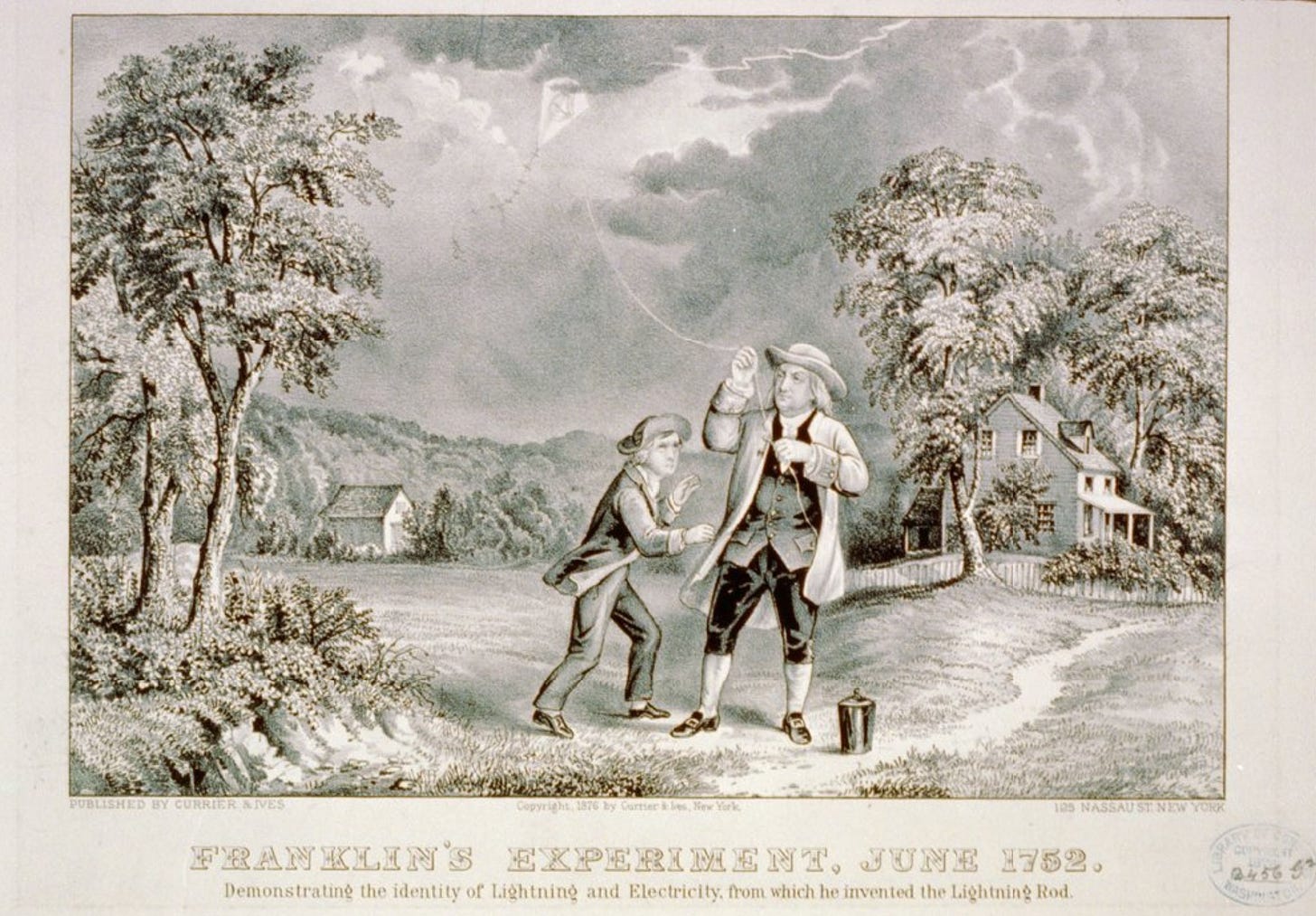TDIH: Benjamin Franklin's Kite
Benjamin Franklin famously flies a kite during a thunderstorm. He discovers that lightning carries electricity. Or did he?
On or around this day in 1752, Benjamin Franklin famously flies a kite during a thunderstorm. He discovers that lightning carries electricity.
Or did he?
“The episode of the kite,” biographer Carl Van Doren writes, “so firm and fixed in legend, turns out to be dim and mystifying in fact.”
As it turns out, Franklin wasn’t the first to demonstrate that lightning carries electricity with his June 1752 attempt. Instead, that honor goes to a group of French scientists. They set up a tall iron rod, insulated it from the ground, and successfully produced sparks from lightning during May 1752.
A cynical perspective on this timeline is sometimes espoused: Did Franklin make up or exaggerate his kite story so Paris scientists wouldn’t steal his thunder? (Pun intended!) The episode doesn’t appear in Franklin’s diary, and there was only one witness to the experiment—Franklin’s son. On the other hand, Franklin didn’t know about the French experiment until sometime after June 15. He really may have conducted his own experiment and thought he was the first, at least for a while.
Either way, the French scientists had been reading Franklin’s work, and they were simply setting up and running an experiment that had originally been Franklin’s idea. It seems only fair to credit Franklin for the discovery about lightning.
Therein lies another myth, of course. Franklin didn’t discover electricity itself, despite misperceptions of the event. Scientists already knew about electricity, and they knew how to store static electricity in a device called a Leyden Jar. Franklin learned of these experiments in 1746. Ever curious, he began conducting his own experiments, too.
By July 1750, he was mulling over ideas for proving his theory that lightning carries electricity. He sent some of his ideas for “determin[ing] the Question, Whether the Clouds that contain Lightning are electrified or not” to a friend and fellow scientist in London.
At least reportedly, he decided to conduct his kite experiment on or around June 15, 1752.
Two accounts back up the story. First, a scientist by the name of Joseph Priestley wrote an account of the day, although he did so 15 years after the fact. It’s believed that he obtained details from Franklin himself. And, while Franklin didn’t write a direct account of the day, he did write instructions on how to replicate his experiment.
Franklin reportedly attached a metal rod to the top of a kite, effectively creating a lightning rod. The kite was attached to a hemp string and a metal key, which would conduct electricity into a Leyden jar. The hemp string was attached to a silk string that Franklin would be holding from his position in a shed. He needed to keep himself—and the silk string—dry so electricity wouldn’t come down the line to his hand.
One final myth? The kite wasn’t struck by lightning. Instead, it picked up ambient electrical charges in a storm. If it had been directly struck, the silk string would not have been enough to protect Franklin.
Ultimately, Franklin’s experiments with electricity led to an invention that is widely used today: the lightning rod. In an interesting twist, Franklin’s rod became yet another way in which the colonists could revolt against England.
The King thought a blunt tip on a lightning rod was better than Franklin’s pointed tip.
“When it came time to equip the colonies’ buildings with lightning rods,” the Franklin Institute concludes, “the decision became a political statement. . . . [The pointed lightning rod] became a symbol of the ingenuity and independence of a young, thriving nation, as well as the intellect and inventiveness of Benjamin Franklin.”
Sources can always be found on my website, here.





Franklin was one of the great minds of his day! We owe him much, even the rocking chair!!!
Franklin was an amazing man. Credit for his discoveries are due him.